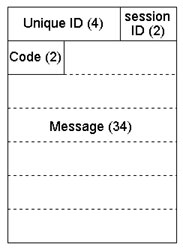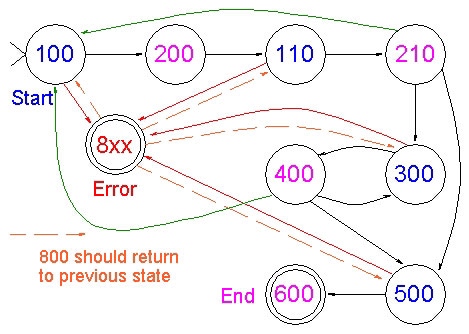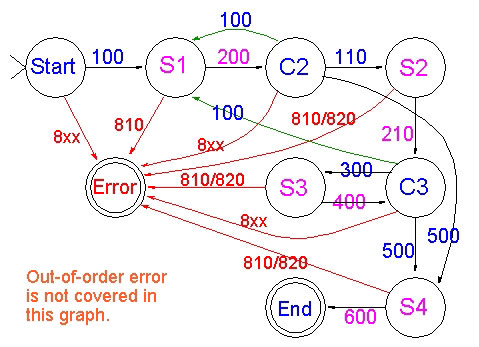UNIVERSITY of
HOUSTON
Department of Computer
Science
COSC 4377
- Introduction to Computer Networks
Section
07925
Fall 2000
Assignment 2 - Socket Programming
Due on Monday, October 16, 2000
This programming assignment is designed to let you familiar with BSD sockets ,
client-server application, and persistent connection. This assignment weights
200 points.
The usual note:
- At the beginning of each file, you should include
"COSC 4377, Fall 2000, Assignment #2", your NAME, and your
E-MAIL address in the comment.
- Structural programming and good programming style are necessary.
- Comments / in-line documents for functions and variables are
a must.
- You can discuss with your classmate, but no collaboration / copy. And your
programs will be checked by
MOSS (Measure Of Software Similarity) to find any similarity. Any student
found guilty of academic dishonesty will receive severe punishment.
- You are responsible for ensuring the code you write for the assignment
is not readable by others.
Latest Hint:
Please see FAQ.
Overview:
You will write two C/C++ programs using BSD sockets (using AF_INET
and SOCK_STREAM) to implement
a client and a server which follow a protocol (called Oracle) to exchange message
and perform some functions on server. There will be only one client and one
server for this assignment.
- After connection between client and server is established, client sends
a "Hello" to server.
- Server responses with an "OK" and a random session id (client will use
this session id to communicate with server).
- Then client sends the user name, and server responses with "HI username".
- Client sends a question to server and server responses with an answer.
The sample questions are "server name", "date/time", "user name", "add 1
2", "subtract 4 2", etc.
- At the end of message exchange, client sends "Bye" to server and server
responses with "Bye username". And then connection is closed.
- If client sends another "Hello", server issues another random session
ID. And continue as (3).
- Server keeps track of client's hostname, current user's name and session
ID. If client's session ID doesn't match current session ID at server, server
sends an error message and terminates the connection.
- Each message includes a unique ID (4 bytes, first 2 letters of your last
name + first letter of your first name + last digit of your SSN). Client
and server has a copy of this unique ID. If server receives a message with
different unique ID, server responses a error message and closes the connection.
- If any command received by server is out-of-order (for example, server
receives "ASK" command as the first massage from client), server
responses an error message and terminate the connection.
Oracle Protocol
Message format

Each message has 42 bytes which are consisted of 4 parts.
- Unique ID (4 bytes, characters): Unique ID is used as an identification
between client and server, so client communicates with intended server.
Unique ID is constructed by first two letters of your last name + first
letter of your first name + last digit of your SSN.
- Session ID (2 bytes, an unsigned integer): Session ID is randomly generated
(greater than 0) and assigned by server. When client connects to server
with a "HELO" command, server will return a session ID. Session
ID "0" is used only for client sending "HELO" command.
- Code (2 bytes, an unsigned integer): The code is used to identify the
actions between client and server.
- Message (34 bytes, characters): The message part contains the actions
or information to be exchanged. All commands are in upper case and words
in the messages are separated by space.
Messages exchanged between client and server
The messages exchanged between client and server are listed (but not limited
to) in the following table. You can add extra error messages to cover out-of-order
commands.
|
Sent from
|
Code
|
Message
|
Explanation
|
|
Client
|
100
|
HELO from clienthost
|
send client's hostname (clienthost) to server
|
|
110
|
USER username
|
send client's current user name (username)
|
|
300
|
ASK SRVR
|
request server's hostname
|
|
ASK SNID
|
request current session ID
|
| ASK CLNT |
request client's hostname
|
| ASK USER |
request current user's name |
|
ASK DATE
|
request date and time on the server
|
|
ASK ADD numbr1 numbr2
|
request the result of (numbr1 + numbr2)
|
|
ASK SUB numbr1 numbr2
|
request the result of (numbr1 - numbr2)
|
|
500
|
BYE |
notify the end of connection
|
|
Server
|
200
|
OK SNID |
reply with session ID (SNID)
|
|
210
|
HI username |
acknowledge current user (username)
|
|
400
|
ANSW result |
reply with the result requested by ASK command
|
|
600
|
BYE usrname from clnthost |
acknowledge the termination to current user (usrname)
at client (clnthost)
|
|
800
|
ERR unknown command |
server receives an unknown command
|
|
810
|
ERR incorrect UNIQ ID |
server receives mismatched unique ID
|
|
820
|
ERR incorrect SNID |
server receives mismatched session ID
|
|
...
|
...... |
...... |
The state diagram of messages exchanged between client and server is described
in the following feature.

There were some confusions regarding the state diagram above.
So I drew another state diagram to make the transition between different
states easier to understand. Start, C2, C3, and End are on the client; S1,
S2, S3, and S4 are on the server. "Error" state indicates server
receives a message containing error(s) and labels on the edges reaching "Error"
state indicate the messages sent to client.

Requirements:
Discussion Questions:
- When client receives message from server, client finds the unique ID from
server is different from client's (somehow another server hijacks the connection
and uses different unique ID.) Should client close the connection right
away, or sent a message to server before close the connection? Which way
is better? Why?
- Why does this protocol provide persistent connections?
- When server receives an out-of-order command, it would be better to tolerate
the error and continue the execution (instead of terminate the connection).
Give an example (or sequence) that server receives an out-of-order command
and continues execution and still preserve the authentication sequence ("HELO"
and then "USER"). You may add extra message to achieve
fault-tolerance.
Submit your assignment: (updated)
- You should turn in all necessary programs (client, server, include
files, makefile, readme, etc.)
- Your document should include in-line document / comments in your
programs, instruction to run your programs, special instruction for
compilation, sample outputs (at least one with error and one without),
answers to discussion questions, and comments.
- Here is how to submit your programs and documents (must run on pegasus
or SunOS machines in the CS Dept).
- Your programs, readme, makefile
(due midnight, Monday, Oct. 16, 2000):
run the following command
~xjiang/submit assignment# file1 file2 ...
where assignment# is which assignment you want to submit
(in this case it's "2"), and file1, file2, ... are the files
you want to submit. Here is an example for submitting 4 files for
Assignment #2.
~xjiang/submit 2 Makefile server.c client.c readme.txt
- Discussion questions and comments:
Please turn-in hardcopy in the Monday's class
.
- If you have trouble submitting your programs, or you can't get
your CS account in time, you can email your programs to
TA,
Mark, or
Dr. Subhlok.
Reference:
- A simple
Socket example - a simple but sufficient example for this assignment.
You can use this example as a base to implement your programs. I have added
some debugging messages and you can download here (client.c,
server.c, and readdir.c).
- BSD
Sockets: A Quick And Dirty Primer - a brief introduction to Sockets.
-
BSD Sockets - a more detail introduction to Sockets with examples.
- Davin's
collection of UNIX programming links - an excellent resource for UNIX
programming (including Sockets).
- A great UNIX network programming reference book, "UNIX Network Programming,"
by W. Richard Stevens, Prentice Hall, 1990. (ANDERSON/RESERVES QA76.76.O63
S755 1990). Sockets programming covered in 84 pages.
- Another book about client/server programming is "Power Programming
with RPC," by John Bloomer, O'Reilly, 1991. (ANDERSON/RESERVES QA76.8.U65B4
1991 3-WK LOAN). You can find some sockets programming example from this
book (actually the example in the first link is from this book.) Socket
programming covered in 25 pages.
- If you want to know how sockets is implemented, you should check out "TCP/IP
Illustrated, Vol. 2 - The Implementation," by Gary R. Wright and W.
Richard Stevens, Addison-Wesley, 1995. Sockets covered in 124 pages.
- The slide I used in the class is from "TCP/IP Protocol Suite,"
by Behrouz A. Forouzan, McGraw-Hill, 2000. This is a good reference book
for TCP/IP protocols, but it's quite expensive. This book gives explanations
on data structures and functions. The examples provided are not compilable.
Sockets covered in 34 pages. You can get all the overhead
slides of this book from Kevin Long's web page.
Last modified: October 12, 2000.
tihuang at cs . uh . edu


